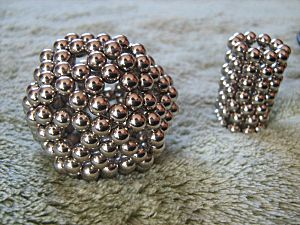Neodymium magnet toys facts for kids
Neodymium magnets are very strong magnets, often made into small spheres. People have used them for different things, like educational toys, items to help with stress, and even for art.
In the United States, between 2009 and 2013, about 2,900 people went to the emergency room because of these small, powerful magnets. Most of these incidents involved either ball-shaped magnets or very strong magnets. Because of this, the U.S. Consumer Product Safety Commission (CPSC), which is a government group that makes sure products are safe, has been trying to ban them.
Contents
Why Were Magnets Recalled?
Some of the first popular magnet sets were called Buckyballs. They were launched in 2009 and sold hundreds of thousands of units. The CPSC later issued a recall for packages that said "13+". This meant they thought the product was not safe for people under 13. Even though 175,000 units were sold, very few were returned. However, Buckyballs that said "Keep Away From All Children" were not recalled.
After this, the company that made Buckyballs, Maxfield & Oberton, started calling their product a "desk toy" instead of a "toy." They wanted people to see it as something for adults to relieve stress. They also stopped selling them in stores that mainly sold children's products.
The CPSC looked into the issue more in 2012. They found that more and more young children and teenagers were swallowing these magnets. For older kids and teens, it often happened by accident when they tried to use the magnets to look like body piercings, such as tongue studs. The CPSC warned that if more than one magnet is swallowed, they can stick together inside the body. This can cause serious health problems.
Another recall for Buckyballs and similar magnet products was issued in 2012. The CPSC also took action against other companies selling similar products in the U.S. Maxfield & Oberton did not agree with the recall and kept selling their desk toys. The company even started a public campaign against the CPSC. Eventually, in late 2012, Maxfield & Oberton announced that the company no longer existed.
New Safety Rules for Magnets
Because there were no specific safety rules for strong magnets outside of toys, the CPSC suggested new rules in 2012. These rules aimed to ban all loose sets of strong magnets from being sold in the United States, no matter what they were used for. The CPSC worked hard to get support from doctors, consumer groups, and health agencies in other countries.
However, in 2016, a court in the United States disagreed with the CPSC's 2012 rule. This meant that selling small neodymium magnets became legal again in the U.S. It was not clear at that time if the CPSC would try to create a new rule.
In 2017, a company called Zen Magnets LLC asked the CPSC to create new safety rules for magnets. These new rules suggested:
- Safety Limits: Magnets that are small enough to fit into a special test cylinder (meaning they are small parts) should not be too strong if they are made for children under 14. This would make sure they don't stick together across body tissue if swallowed.
- Packaging: Packaging should be hard for children to open. It should also help users make sure all magnets are put back after use.
- Warnings: Magnet sets should have clear warnings about the danger of swallowing them. These warnings should also say that the product is not for children. Warnings should be easy to see, even when opening the package.
- Instructions: Magnet sets should include instructions on how to avoid swallowing or putting magnets into the body. They should also explain how to put the magnets back into their packaging.
- Age Recommendations: Warnings and instructions should say that the magnet sets are for people aged 14 years or older.
The CPSC could not agree on a new rule. So, some companies started selling the products again without warnings for children. As of 2019, companies are working with a group called ASTM to create their own voluntary safety standards.
United States Rules
In June 2012, after a letter from U.S. Senator Kirsten Gillibrand, the United States Consumer Product Safety Commission tried to ban the sale of Buckyballs and Zen Magnets. Zen Magnets LLC was the first company to face such a complaint without any reported injuries. In November 2012, Buckyballs announced they had stopped making their products because of the CPSC lawsuit.
In March 2016, Zen Magnets (a company that makes neodymium magnet spheres) won a court case. The court decided that if Zen Magnets and similar products called Neoballs are used correctly, they are not dangerous.
As of January 2017, many brands of magnet spheres, including Zen Magnets, started selling small neodymium magnet spheres again. This happened after Zen Magnets won an appeal in court, which overturned the CPSC's 2012 ban. This made selling small neodymium magnets legal again in the United States. It was the first time the CPSC had lost such a case in over 30 years.
A study published in a medical journal found that after 2017, there was a big increase in children swallowing magnets. It also showed a five-fold increase in serious cases where children needed more medical help because they had swallowed multiple magnets.
Canada Rules
In Canada, selling "small, powerful magnets" has been against the law since 2015.
Australia Rules
In November 2012, after a temporary ban in New South Wales, a permanent ban on selling neodymium magnets was put in place across all of Australia.
New Zealand Rules
In January 2013, the Consumer Affairs Minister, Simon Bridges, announced a ban on bringing in and selling neodymium magnet sets in New Zealand. This ban started on January 24, 2013.
|





